

The NILOS ring is the ideal solution for your sealing problem:
Tight for more than 60 years. In almost all areas:
Two basic shapes of seals AV, JV
These two types of NILOS-Rings cover the majority of configurations used. The standard types of NILOS-Rings can be used for peripheral rotating speeds of up to 6 m/s; higher speeds must quoted without fail when ordering.
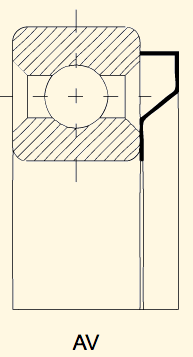
A NILOS-Ring that seals the outer roller bearing ring is described as a type AV. Description: An “externally-sealing” NILOS-Ring for a single-row 6410 AV deep groove ball bearing is described as type “6410 AV”.

In design work the types of NILOS-Rings that seal the inner roller bearing ring should be used if at all possible. For preference, use the corresponding NILOS-Rings of type JV. Description: An “internally-sealing“ NILOS-Ring for a single-row 6410 deep groove ball bearing is described as type “6410 JV”.
For Z and RS bearings ZAV, ZJV
The sealing of bearings that have already been provided with shields or seals is done by NILOS-Rings of other dimensions so that the seal clamped into the bearing is fully encapsulated by the NILOS-Ring. NILOS-Rings are required in particular in such cases if dirt can penetrate up to the bearing or if condensation is formed.

A NILOS-Ring that seals the outer roller bearing ring is described as a type “ZAV”. Description: An “externally-sealing” NILOS-Ring for a single-row deep groove ball bearing 6205 with integrated shields or seals is called type “6205 ZAV”.
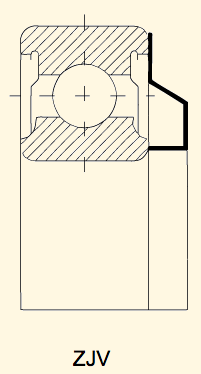
Preference should also be given in the design for NILOS-Rings that seal the inner roller bearing ring if possible, these are called type “ZJV”. For preference, use the corresponding NILOS-Rings of type “ZJV”. Description: An “internally-sealing“ NILOS-Ring for a single-row deep groove ball bearing 6205 with integrated shields or seals is called type “6205 ZJV”.
Shapes for taper roller bearings type AV,JV and AK
For taper roller bearings AV, JV, AK
The two forms of NILOS-Ring, the AV and the JV, are produced for the bearing sides shown in the illustration. The dimensions of the sealing edge are significantly different from those for other forms due to the difference in width between the inner and outer bearing rings. They are dimensioned to guarantee to be always in place on the roller bearing ring and thus ensure that proper sealing is achieved in all cases.
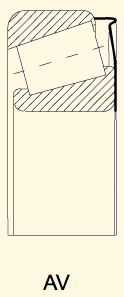
A NILOS-Ring that seals the outer roller bearing ring is described a type “AV”. Description: An “externally-sealing” NILOS-Ring for a single-row 302 07 taper roller bearing is described as a type “302 07 AV”.
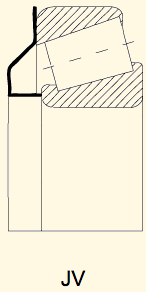
A NILOS-Ring that seals the inner roller bearing ring is described as a type “JV”. Description: An “internally-sealing “ NILOS-Ring for a single-row 302 07 taper roller bearing is described as a type “302 07 JV”.
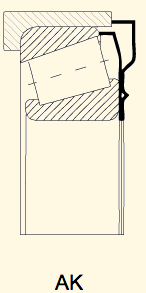
A second type of external seal for taper roller bearings is the NILOS-Double-Ring, here described as a type “AK” . Description: A “double externally-sealing” NILOS-Ring for a single-row 313 11 taper roller bearing is described as a type “313 11 AK”.
Steel disk seal LSTO
Sealing package comprising of steel disks are ready for installation and capable of handling thrust loads. The sealing works on a non-contact basis and can follow axial movements of the roller bearing rings to 0.3 mm without any jamming of the disc.
Type LST-L steel disk seal
The type LST-L ring is a further development of the type LSTO NILOS ring. By means of an additional Viton gasket, a considerable sealing effect is achieved when in contact with liquids.
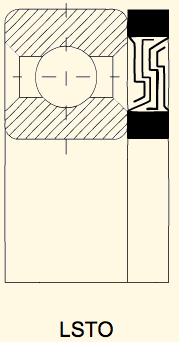
The NILOS-Ring type “LSTO” has been designed for bearing points that are subject to exceptionally high levels of dirt. Description: A NILOS steel disk seal that is ready for installation for a roller bearing of 30 mm internal diameter and 55 mm external diameter is called in NILOS-Ring abbreviation “30 x 55 LSTO”.
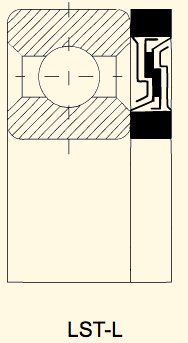
The NILOS-Ring type “LST-L” is suitable where a variety of liquids is used. Description: with the NILOS ring symbols “25 x 47” LST-L, a steel disk seal with an additional Viton gasket for a roller bearing with an inner diameter of 25 mm and an outer diameter of 47 mm, is designated.
DIFKU sealing springs for ball bearings
These sealing springs are axial seals with the best possible spring properties and have an inside recess as well as a sealing edge. They are made of various types of materials and their shape can be adapted to any type of installation situation and bearing position. Vertical sealing edges and concentric location is a prerequisite for all DIFKU sealing springs. This produces the labyrinth groove on the facing surface of the ball bearing required for a good sealing effect.
DISKU sealing springs for ball bearings
Simple cover plates protect against severe contamination from outside and offer the maximum amount of resistance. They are generally used as additional protection for bearings, since not all seals can offer protection to the inside and the outside. A solution using DISKU cover plates saves costs and space. The mating contacting surface should be carefully machined if it is to be used as a rubbing cover plate.
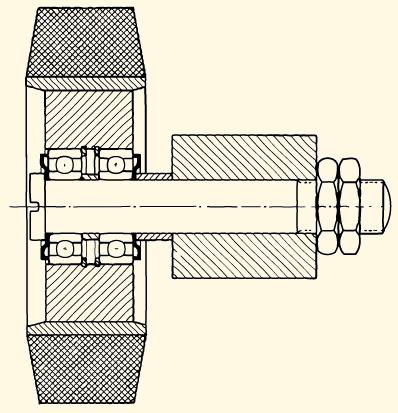
DISKU special ring in an escalator idler.
Filling the NILOS-Ring with grease
In order to reduce the moment of friction during first start-up, the dished sealing groove is to be filled with grease before fitting. Once the NILOS-Ring has been fully run in, it does not need any further maintenance.
Grease chamber in the NILOS-AK-Ring
The space between the two sealing edges of the NILOS-AK-Ring should likewise be filled with grease before installation. Under normal operating conditions the type of grease used to lubricate the taper roller bearings can also be used. In special cases, especially if it is necessary to take into account a severe intrusion of water into the bearing position, the grease chamber should be filled with a water-repellent sealing grease.
Sealing effect
Sealing is produced by placing the sealing edge of the NILOS-Ring under light pressure at the inner or outer roller bearing ring and so that it rubs to a greater or lesser depth into the hardened roller bearing ring. The fine labyrinth that is produced as a result prevents both the leaking of grease and also the penetration of dirt into the bearing.
If the design allows it, inner-sealing NILOS-Rings should be used in all cases.
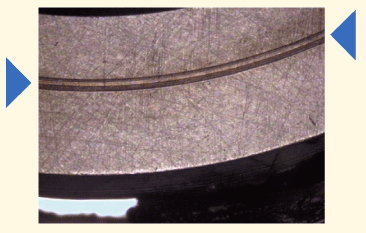
Basic rule: Concentric location
As with all sealing elements, the sealing edge of the NILOS-Ring must be exactly concentric. This is the only way to produce the sealing effect required for the labyrinth groove. The externally-sealing NILOS-Ring should be installed so that it rubs lightly on the shaft, the inner sealing ring must be located centrally within the bearing casing hole.
The inner and outer edges of the inside recess should therefore not be on or in threads, thread runouts, pushed-up sections or hollow sections. The radius at the shaft or casing shoulder must be ≤ 0.1.
Space required “h1”
Installation height “h” is given as the maximum dimension within the dimensional tables down to which there is no effect on the sealing action. It is therefore always sufficient if the space required is taken into consideration with “h1” = h + 1 mm.
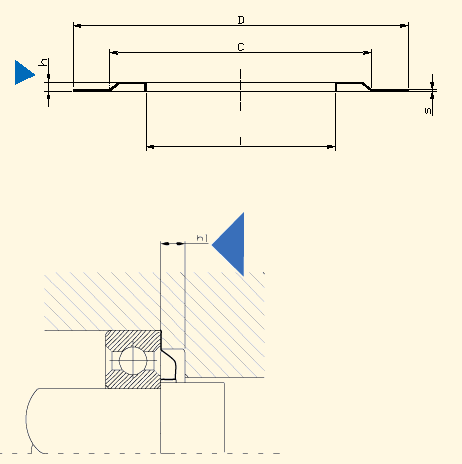
Non-slip clamping required
The NILOS-Ring must not slip at the clamping point. With an externally-sealing NILOS-Ring a firm location of the roller bearing into the shaft shoulder is adequate for non-slip clamping, and in the case of an internally-sealing NILOS-Ring the type of clamping elements normally used are also adequate.
Self-aligning and barrel-type bearings
Self-aligning and barrel-type bearingsNILOS-Rings can be used if these bearings are to be used only due to their higher loading capacities. The NILOS-Ring is not suitable for sealing if these bearings are to be used according to their intended purpose for self-aligning movements >1°.
Cylindrical roller bearings without rim
NILOS-Rings of type LSTO should be used exclusively for these and a series of similar bearings, since they can accommodate the axial shifts of these bearings to a certain extent (max. 0.3 mm).
Taper roller bearings
NILOS-Rings of type AV, JV and AK are suitable to seal taper roller bearings for the bearing sides quoted. The installation of the taper roller bearings and also the associated NILOS-Rings must be done with particular care and accuracy to ensure that the sealing edges of the NILOS-Rings are not damaged.
Connection dimensions
The NILOS-Ring fits all roller bearings with rounding and shoulder heights as per DIN 5418, with the exception of the smallest bearings. In the case of roller bearings of makes that deviate from this, it is possible to provide special configurations of NILOS-Rings as necessary. The connection dimensions for NILOS-Rings of type AK are given separately in the relevant dimensional tables.
NILOS- Ring AV / JV
The NILOS-Ring is a contact-type seal in its standard form, both in AV and in JV form. Only once it has run-in into the bearing ring it produces a non-contact gap seal in the µ-range after a certain running-in period. The standard types of NILOS-Rings can be used for peripheral rotating speeds of up to 6 m/s. However, this speed range is not adequate for many applications. But even then you do not have to give up the customary reliability of NILOS-Rings as sealing elements. If it is possible to run in the unit at below 6 m/s, the sealing edge is fully run in after 24 hours and can then be operated without harm at higher speeds.
If a running-in process is not possible, NILOS-Rings can be installed with reduced Preload or minus preload. In this case please quote the operating r.p.m. when ordering. The corresponding preload will be determined by us on the basis of the type of application and the speed. The JV types of ring should be used for peripheral rotating speeds above 15 m/s.
NILOS-Rings type LSTO
The LSTO rings are a non-contact sealing system and can be used for a circumferential speed of up to 30 m/s.
NILOS-Rings type LST-L
By means of an integrated Viton gasket operation at circumferential speeds of up to 3 m/s are possible in case of permanent contact with liquids. If LST-L type NILOS-rings are used in applications with liquids to which they are not permanently exposed, the circumferential speed is restricted to 1 m/s.
Deep-groove ball bearings
When installing deep-groove ball bearings in NILOS-Rings, the NILOS-Ring can be damaged as a result of the axial play of the bearing. We therefore recommend paying special attention to the following illustrations.
These pictures exaggerate the situation to make the cause and effect of incorrect installation more obvious.
Incorrect installation of a deep-groove ball bearing, without installation aid. The NILOS-Ring is deformed.

Correct installation of a deep-groove ball bearing.

Incorrect installation of a shaft in a deep-groove ball bearing without installation aid.

Correct installation of a shaft in a deep-groove ball bearing.
Taper roller bearings
When installing NILOS-Rings of types AV or AK in taper roller bearings, it is necessary to pay special attention to one particular point: The pivot pins of the bearing housing must be installed precisely in the centre and parallel both for horizontal and vertical installation (16.2). They can be skewed when installed, and under unfavourable circumstances the sealing edge can be damaged so much that it is no longer possible to guarantee proper sealing.

Dimension “w” applies for NILOS-Rings of type AK in the relevant dimensional tables for the diameter of the circle on which two retaining nubs are provided to prevent it from rotating. When installing the NILOS AK-type ring, it is necessary to ensure that the two retaining nubs click into the corresponding cut-outs in the shock ring or in the pivot pins.

The two retaining nubs on NILOS AK-type rings are opposed by 180°, they have a diameter at the base of around 4 mm and a height of approx. 1.5 mm. Depending on the options available for production, the bearing part to be pressed in can either have two matching recesses or – which makes easier installation possible – a 2 mm deep and 4 mm wide groove can be arranged. This groove is then interrupted by a small positioning pin that locks one of the two retaining nubs to prevent possible twisting or rotation.
Bearing incidence
A number of different processes are used in the various factories concerning the angle of incidence of taper roller bearings. A distinction is made between the following procedures, among others:
1. Tightening up the bearing thread until the axial play is “0” (16.3) by using a standard spanner. Then the screw connection is undone by a certain amount (1/6 to 1/12 turn) in order to produce the desired bearing play and thus lock the screwed connection (16.4).


2. Tightening up the screw connection with a torque wrench to a previously determined and always consistent torque. Then loosening and locking the screw connection as described in 1. above.
3. Tightening up the screw connection either with a standard spanner, then undoing the screw connection and measuring the axial play of the bearing, and correcting the axial play as necessary by loosening or tightening the screw connection further. Locking the screw connection once the desired axial play has been reached.
NILOS-Rings of type AV or AK can be installed without any problems for all types of setting-up. The axial forces to be aimed at in setting up the bearing with the screw connection are several times higher than the force acting on the NILOS-Ring sealing edges. The force acting on the NILOS-Ring sealing edge is thus to some extent perceptible when turning the bearing. Thus under no circumstances should it be assumed that the bearing does not have the necessary axial play. The NILOS-Ring has been run in after the shortest possible running time at operating r.p.m..
The elasticity of the NILOS-Ring material also makes it possible to measure the axial play of the bearing. Thus there is no danger that the sealing edge of the NILOS-Ring lifts up from the taper roller bearing or will remain deformed when measuring the axial play.
The intrinsic elasticity of the NILOS-Ring is many times higher than the normal permissible axial play of the bearing.
Important:
There must be at least 1 mm clearance between the NILOS-Ring and the adjacent machine part behind the outside diameter of the NILOS-Ring.
Cover or sealing plates for Z and RS bearings are not always adequate for the requirements placed upon them so that they need to be saled in addition with NILOS-Rings. Working in collaboration with the roller bearing industry, NILOS-Rings of types ZAV and ZJV were produced to seal bearings of this type. The job of these NILOS-Rings is to protect against dirt contamination; they prevent above all a relatively quick destruction of the sealing lip in deeep-groove ball bearings of RS design. The design suggestions can only illustrate the fitting of NILOS-Rings in a general way and point out the most likely mistakes.
Most likely mistakes

Image 1: Right installation
Particular attention must be given to the design as far as keyways or grooves are concerned.

Image 2
The bearing housing does not allow enough space for the seal width. At least 1 mm clearance behind the NILOS-Ring is necessary.

Image 3
The clamping of the NILOS-Ring is insufficient if the shaft shoulder is too small in diameter; a solution may be the NILOS distancering.

Image 4
Every sealing element must run absolutely concentric. The NILOS-Ring must therefore according to its application either be centered on the bearing housing or on the shaft.

Image 5
Problems may occur with this design on the left page regarding the circlip groove and the NILOS-Ring especially during the mounting process. A solution may be the NILOS-Spacer-Ring.
You can send a direct message to NILOS Ring
BearingEXPO connects 40+ physical exhibitions in
various key industry segments
Ask us the product, service or
company that you are looking for